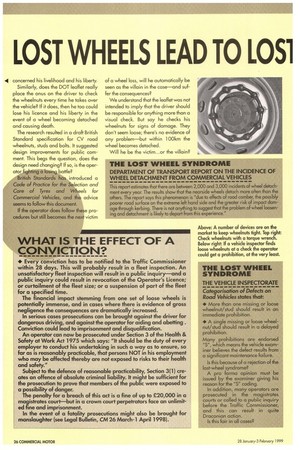THE LOST-WHEEL SYNDROME
Page 27

Page 28

If you've noticed an error in this article please click here to report it so we can fix it.
CARELESS TORQUE COSTS LIVES
The Department of Transport has produced a guidance leaflet for HGV operators, Careless Torque Costs lives, to help them reduce the incidence of wheel loss. It says this problem is no mystery...
• No one can argue with the motives behind the DOT's latest attempt to reduce the number of lost-wheel incidents, but similar leaflets have been published since as long ago as May 1991 with no obvious effect.
So why then is it that, despite these best-practice recommendations, HGV wheels are still coming loose?
The latest leaflet states: "There has been a lot of research into the problem of wheel-loss, which is why IT IS NOT A MYSTERY." It reports that this research cites two major factors:
• Low quality replacement parts; • Relaxation of tension in the wheel fixing after initial tightening.
This gives the impression that wheel insecurity can be blamed on poor maintenance by operators.
In a case recently reported in CM, the North Eastern Traffic Commissioner referred to the DOT leaflet as the definitive comment on the subject, presumably because it was produced by a vehicle examiner at the public inquiry.
As a result of this, any operator called to a public inquiry for loose wheelnuts could be assumed to be at fault because of a failure in his maintenance system. Would this be a fair assumption?
The leaflet says that a wheel maintenance system should "ensure that wheel fixing is checked regularly, preferably at the start of each shift. Loose wheel fixings can be checked by using a torque wrench, socket and short bar, or maybe by striking the nuts with a small hammer. If the driver is responsible for this check, make sure that he or she is properly trained."
This has been interpreted by some enforcement officers and prosecutors to mean that every driver must carry out a pre-use check every day using a torque wrench, socket and short bar, or tapping hammer.
But is this the real meaning of this paragraph? And is it in the best interests of the industry and the public to put the onus on the operator, his maintenance staff and the driver?
Does the research referred to in the leaflet really conclude that bad maintenance is the cause of lost wheels? If so, the loss of a wheel could cost the haulier 110.
41 concerned his livelihood and his liberty. Similarly, does the DOT leaflet really place the onus on the driver to check the wheelnuts every time he takes over the vehicle? If it does, then he too could lose his licence and his liberty in the event of a wheel becoming detached and causing death.
The research resulted in a draft British Standard specification for CV road wheelnuts, studs and bolts. It suggested design improvements for public comment. This begs the question, does the design need changing? If so, is the operator fighting a losing battle?
British Standards has introduced a Code of Practice for the Selection and
tiuCare of Tyres and Wheels for Commercial Vehicles, and the advice seems to follow this document. If the operator does follow these procedures but still becomes the next victim
of a wheel loss, will he automatically be seen as the villain in the case—and suffer the consequences?
We understand that the leaflet was not intended to imply that the driver should be responsible for anything more than a visual check. But say he checks his wheelnuts for signs of damage. They don't seem loose; there's no evidence of any problem—but within 100km the wheel becomes detached.
Will he be the victim.. .or the villain?








































































































